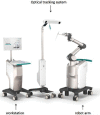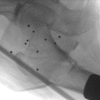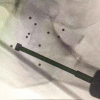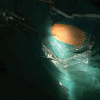Intramedullary Nail Fixation Assisted by Orthopaedic Robot Navigation for Intertrochanteric Fractures in Elderly Patients
- PMID: 31004410
- PMCID: PMC6594474
- DOI: 10.1111/os.12447
Intramedullary Nail Fixation Assisted by Orthopaedic Robot Navigation for Intertrochanteric Fractures in Elderly Patients
Abstract
Objective: To compare the clinical efficacy of intramedullary nail fixation for intertrochanteric fractures assisted by orthopaedic robot navigation and the traditional intramedullary nail fixation in elderly patients, and to investigate the application advantages of intramedullary nail fixation for femoral intertrochanteric fractures assisted by orthopaedic robot navigation in the elderly.
Methods: Among the 51 patients with intertrochanteric fractures who were selected from April 2015 to September 2017 in the Affiliated Hospital of Chengdu University, 25 patients underwent the intramedullary nail fixation assisted by orthopaedic robot navigation (orthopaedic robot navigation surgery group) and 26 patients underwent the traditional intramedullary nail fixation (traditional surgery group). The operation time, the number of intraoperative fluoroscopy images taken, the frequency of guide pins inserted into the femoral marrow cavity, the amount of intraoperative bleeding, and the one-time success rate of the guide pin inserted into the femoral marrow cavity were recorded. Fracture healing and internal fixation were observed. The Harris score was used to evaluate hip joint function 1 year after surgery.
Results: All patients were followed up for 12-24 months. The operation time was 65.44 ± 8.01 min in the orthopaedic robot navigation surgery group and 77.50 ± 16.64 min in the traditional surgery group. The number of intraoperative fluoroscopy images taken was 10.28 ± 0.61 in the orthopaedic robot navigation surgery group and 13.23 ± 1.75 in the traditional surgery group. The frequency of guide pins inserted into the femoral marrow cavity was 1.00 ± 0.00 times in the orthopaedic robot navigation surgery group and 2.46 ± 1.10 times in the traditional surgery group. The one-time success rate of intramedullary pin puncture was 100% (25/25) in the orthopaedic surgical robot navigation surgery group and 19.23% (5/26) in the traditional surgery group. The amount of surgical bleeding was 90.80 ± 14.98 mL in the orthopaedic robot navigation surgery group and 118.46 ± 32.21 mL in the traditional surgery group. Compared with the traditional surgery group, the operation time of the orthopaedic surgical robot navigation surgery group was shorter (P < 0.05), the number of intraoperative fluoroscopy images taken was fewer (P < 0.05), the frequency of guide pins inserted into the femoral marrow cavity was lower (P < 0.05), the one-time success rate of intramedullary pin puncture was higher (P < 0.05), and the amount of surgical bleeding was less (P < 0.05). One year after surgery, fracture healing occurred in both groups without failure of internal fixation or fracture displacement. The Harris score of hip function in the orthopaedic robot navigation surgery group was 86.68 ± 6.23 and that in the traditional surgery group was 82.69 ± 6.85. It was higher than that in the traditional surgery group (P < 0.05). The fine rate of hip joint function in the orthopaedic robot navigation surgery group was 84.00% (21/25) and that in the traditional surgery group was 73.07% (19/26). There was no significant difference between the two groups (P > 0.05).
Conclusion: Intramedullary nail fixation for intertrochanteric fractures assisted by orthopaedic robot navigation in elderly patients is an ideal method, offering a short operation time, minimal surgical trauma, less radiation, and good recovery of hip function.
Keywords: Intertrochanteric fracture; Intramedullary nail fixation; Orthopaedic robot navigation.
© 2019 The Authors. Orthopaedic Surgery published by Chinese Orthopaedic Association and John Wiley & Sons Australia, Ltd.
Figures





Similar articles
-
Treatment of Femoral Neck Fractures with Cannulated Screw Invasive Internal Fixation Assisted by Orthopaedic Surgery Robot Positioning System.Orthop Surg. 2019 Oct;11(5):864-872. doi: 10.1111/os.12548. Orthop Surg. 2019. PMID: 31663277 Free PMC article.
-
Robot Navigation System Assisted PFNA Fixation of Femoral Intertrochanteric Fractures in the Elderly: A Retrospective Clinical Study.Clin Interv Aging. 2024 Jan 5;19:11-19. doi: 10.2147/CIA.S412397. eCollection 2024. Clin Interv Aging. 2024. PMID: 38204959 Free PMC article.
-
[Application of precise-guided temporary fixation assistive devices in proximal femoral nail antirotation fixation for femoral intertrochanteric fractures].Zhongguo Xiu Fu Chong Jian Wai Ke Za Zhi. 2025 Jun 15;39(6):680-685. doi: 10.7507/1002-1892.202503125. Zhongguo Xiu Fu Chong Jian Wai Ke Za Zhi. 2025. PMID: 40545455 Free PMC article. Clinical Trial. Chinese.
-
Whether Assisted Intramedullary Nail Implantation Without Traction Table is as Safe and Effective as Using Traction Table of Older Intertrochanteric Fracture Patients?Clin Interv Aging. 2023 Mar 10;18:387-395. doi: 10.2147/CIA.S399608. eCollection 2023. Clin Interv Aging. 2023. PMID: 36926471 Free PMC article. Review.
-
Hip Replacement as Alternative to Intramedullary Nail in Elderly Patients with Unstable Intertrochanteric Fracture: A Systematic Review and Meta-Analysis.Orthop Surg. 2019 Oct;11(5):745-754. doi: 10.1111/os.12532. Orthop Surg. 2019. PMID: 31663280 Free PMC article.
Cited by
-
Advanced surgical tool: Progress in clinical application of intelligent surgical robot.Smart Med. 2022 Dec 27;1(1):e20220021. doi: 10.1002/SMMD.20220021. eCollection 2022 Dec. Smart Med. 2022. PMID: 39188736 Free PMC article. Review.
-
A Retrospective Study of 98 Elderly Patients with High-Risk Lateral Femoral Wall Intertrochanteric Hip Fractures to Compare Outcomes Following Surgery with Proximal Femoral Nail Antirotation (PFNA) Versus Dynamic Hip Screw (DHS).Med Sci Monit. 2022 Aug 17;28:e936923. doi: 10.12659/MSM.936923. Med Sci Monit. 2022. PMID: 35974685 Free PMC article.
-
Comparison of freehand technique and a novel laser guiding navigation in distal locking of femoral intramedullary nails: a randomized controlled trial.BMC Surg. 2022 Oct 21;22(1):363. doi: 10.1186/s12893-022-01815-5. BMC Surg. 2022. PMID: 36271356 Free PMC article. Clinical Trial.
-
Accuracy and Safety of Robot-Assisted versus Fluoroscopy-Guided Posterior C1 Lateral Mass and C2 Pedicle Screw Internal Fixation for Atlantoaxial Dislocation: A Preliminary Study.Biomed Res Int. 2022 Sep 12;2022:8508113. doi: 10.1155/2022/8508113. eCollection 2022. Biomed Res Int. 2022. PMID: 36132077 Free PMC article.
-
A clinical study on robot navigationassisted intramedullary nail treatment for humeral shaft fractures.BMC Musculoskelet Disord. 2024 Oct 1;25(1):766. doi: 10.1186/s12891-024-07848-6. BMC Musculoskelet Disord. 2024. PMID: 39354426 Free PMC article.
References
-
- Kwoh YS, Hou J, Jonckheere EA, Hayati S. A robot with improved absolute positioning accuracy for CT guided stereotactic brain surgery. IEEE Trans Biomed Eng, 1988, 35: 153–160. - PubMed
-
- Yi B, Wang G, Li J, et al Domestically produced Chinese minimally invasive surgical robot system “Micro Hand S” is applied to clinical surgery preliminarily in China. Surg Endosc, 2017, 31: 487–493. - PubMed
-
- Wang JQ. Advantages and limitations of clinical application of orthopaedic surgical robots. Zhong Guo Yi Kan, 2016, 51: 1–2.
-
- DiGioia AM 3rd. What is computer assisted orthopaedic surgery? Clin Orthop Relat Res, 1998, 354: 2–4. - PubMed
-
- Zhao YP, Tand PF. A review of robot system and its navigational system in orthopaedic surgery. Zhong Guo Jiao Xing Wai Ke Za Zhi, 2016, 24: 242–246.
MeSH terms
Grants and funding
LinkOut - more resources
Full Text Sources
Medical
Miscellaneous

